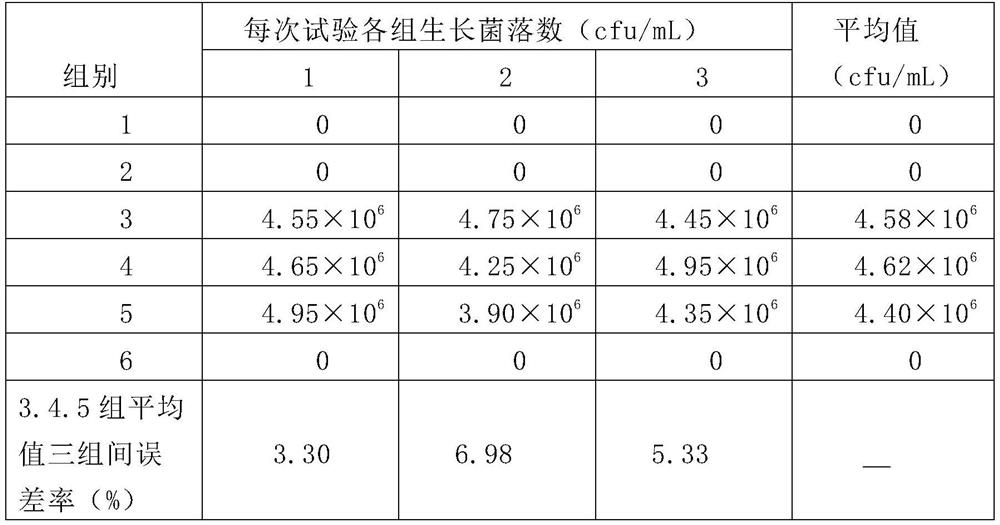Preparation method of chlorine dioxide disinfection sustained-release gel
A slow-release gel and chlorine dioxide technology, applied in botany equipment and methods, disinfectants, chemicals for biological control, etc., can solve problems such as product failure, high space concentration, and secondary pollution, and achieve The storage loss is lower, the gel system is stable, and the storage loss rate is improved.
- Summary
- Abstract
- Description
- Claims
- Application Information
AI Technical Summary
Problems solved by technology
Method used
Image
Examples
Embodiment 1
[0035] A kind of manufacture method of chlorine dioxide disinfection sustained-release gel, its steps are as follows:
[0036] The first step: prepare the gel prepolymer; take 1.23 parts by mass of concentrated sulfuric acid with a mass percentage of 98% and add it dropwise to 12 parts by mass of purified water under stirring to make a dilute sulfuric acid solution for later use; take 0.72 parts by mass of γ-shrink Add glyceryl etheroxypropyltrimethoxysilane, 52 parts by mass of tetraethoxysilane, and 0.51 parts by mass of dodecyl diphenyl ether disulfonic acid sodium salt into the reaction kettle for stirring, and add the prepared dilute sulfuric acid solution Continue stirring in the reaction kettle until it becomes a transparent and uniform hydrolyzate, add 73 parts by mass of purified water to the reaction kettle and stir evenly. After the material in the reaction kettle is heated to 55°C, continue stirring for 35 minutes. The condenser of the reaction kettle Pass the circ...
Embodiment 2
[0040] A kind of manufacture method of chlorine dioxide disinfection sustained-release gel, its steps are as follows:
[0041] The first step: prepare the gel prepolymer; take 1.27 parts by mass of concentrated sulfuric acid with a mass percentage of 98% and add it dropwise to 13 parts by mass of purified water under stirring to make a dilute sulfuric acid solution for later use; take 0.77 parts by mass of γ-shrink Add glyceryl etheroxypropyl trimethoxysilane, 53.5 parts by mass of tetraethoxysilane, and 0.53 parts by mass of sodium dodecyl diphenyl ether disulfonic acid into the reactor for stirring, and add the prepared dilute sulfuric acid solution Continue stirring in the reaction kettle until it becomes a transparent and uniform hydrolyzate, add 78 parts by mass of purified water to the reaction kettle and stir evenly, and continue stirring for 35-45 minutes after the material in the reaction kettle is heated to 65°C. The condenser is fed with circulating water, and the v...
Embodiment 3
[0045] A kind of manufacture method of chlorine dioxide disinfection sustained-release gel, its steps are as follows:
[0046] The first step: prepare the gel prepolymer; take 1.25 parts by mass of concentrated sulfuric acid with a mass percentage of 98% and add it dropwise to 12.5 parts by mass of purified water under stirring to make a dilute sulfuric acid solution for later use; take 0.75 parts by mass of γ-shrink Add glyceryl etheroxypropyl trimethoxysilane, 52.8 parts by mass of tetraethoxysilane, and 0.52 parts by mass of dodecyl diphenyl ether disulfonic acid sodium salt into the reaction kettle for stirring, and add the prepared dilute sulfuric acid solution Continue stirring in the reaction kettle until it becomes a transparent and uniform hydrolyzate, add 75 parts by mass of purified water to the reaction kettle and stir evenly, and continue stirring for 40 minutes after the material in the reaction kettle is heated to 60°C. Through circulating water, start the vacuu...
PUM
 Login to View More
Login to View More Abstract
Description
Claims
Application Information
 Login to View More
Login to View More - R&D
- Intellectual Property
- Life Sciences
- Materials
- Tech Scout
- Unparalleled Data Quality
- Higher Quality Content
- 60% Fewer Hallucinations
Browse by: Latest US Patents, China's latest patents, Technical Efficacy Thesaurus, Application Domain, Technology Topic, Popular Technical Reports.
© 2025 PatSnap. All rights reserved.Legal|Privacy policy|Modern Slavery Act Transparency Statement|Sitemap|About US| Contact US: help@patsnap.com



